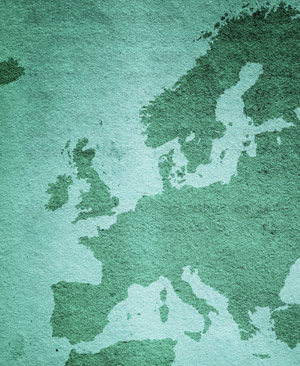AFTER THE TURMOIL: WHAT COMES NEXT?
By Jonathan Gregson, Justin Keay and Vanessa Drucker
How the European Union will look in 2020 is unclear. Whether it will see tighter union, a tiered eurozone, or will cease to exist altogether is at the center of many an analyst’s model and economist’s prediction. What is clear is that it will be a different entity from the EU of 2012—and quite different from the vision of its founders.

As most economists will acknowledge, predicting the future is a hazardous art at best. But one thing seems certain. When the peoples of Europe eight years hence look back on how they arrived at their situation, the years 2012 and 2013 will be pivotal. This year is likely to prove make-or-break time for the euro—and, with it, the grand project of European integration. Global capital markets are impatient for a clear and unqualified signal that the eurozone will hang together; otherwise it will likely be hung out to dry. Confidence in sovereign bonds of heavily indebted euro members will evaporate, and capital flight to perceived ‘safe havens’ only intensify.
A central weakness is that policymakers have been behind the curve, responding to crises rather than heading them off in advance. “European leaders are invariably seen as only doing the minimum necessary,” observes professor Charles Goodhart at the London School of Economics. As a consequence, their policy initiatives are less effective.
The next few months will be crucial. Ratification of new treaty elements, which EU leaders are working on now, is scheduled for March. A whole a raft of sovereign debt auctions and bank refinancings are due before then.
Yael Selfin, head of macro consulting at PwC, says he is “not sure the markets will tolerate uncertainty that long.” So the much-heralded big gun—whether that be a beefed-up European Financial Stability Facility (EFSF), the European Central Bank acting as lender of last resort, an enhanced role for the IMF, acceptance that commonly guaranteed eurobonds be issued, or a combination of all these measures—needs to be rolled out. And sooner rather than later.
Depending on the efficacy of these measures in reassuring financial markets the eurozone will either survive the year or begin disintegrating.
As for the eurozone’s success over the longer term, that will depend on how willing European electorates are to accept the terms of the bargain their leaders are working to reach, which may mean externally enforced austerity and years of recession for the indebted nations; currency depreciation along with higher inflation and borrowing costs for the creditors; and at the end of the day, something approaching a transfer union—where payments flow from richer to poorer member states.
And it is not just economic stability that must be solved, according to Ian Bremmer, president of political risk analysis firm Eurasia Group. Bremmer, speaking in Global Finance ‘s offices on January 11, pointed out that “the continent must solve its long-term competitiveness issues or it will lead to greater political polarization,” particularly in periphery countries and possibly toward more autocratic regimes, he said.
He cited the example of Hungary, where a new constitution—which appears to curtail the independence of judges, the central bank and the country’s data protection agency—was effected late last year under a government viewed by some political watchdogs as increasingly autocratic in its policies, with prime minister Viktor Orbán at the helm. The European Commission is reviewing whether the new Hungarian laws violate the EU Treaty.
ALTERNATE VISIONS
Whatever happens, Europe in 2020 will be a very different place. A number of different visions—based on modeling done by leading market analysts—could become reality for the continent eight years hence.
A UNITED STATES OF EUROPE: Despite reservations by national governments, fuller political union is achieved, economic convergence accelerates and, with mutually guaranteed eurobonds now attractive to international investors, the euro regains it status as a trusted global reserve currency.
Massive monetary expansion begun in 2012 enables the continent to avoid a severe recession, though only at the cost of higher inflation. Germany remains the economic powerhouse, its exports boosted by what PwC analysts estimate would be the euro’s 20% depreciation against the US dollar and other major trading currencies. By 2020 it is basking in a newfound prosperity with GDP growth above 3%. But periphery countries with austerity programs struggle to grow their economies.
BIRD’S-EYE VIEW
Global Finance polls leading economists to get their take on Europe in 2020.
LARGER, MORE COMPETITIVE EUROZONE
Jacob Kirkegaard, research fellow, Peterson Institute
The eurozone in 2020 will be larger than it is today, as political costs will increase for countries choosing to remain outside. Poland and Denmark, for instance, will join before 2020. The UK won’t—a notable exception—for political reasons. No one will leave. While Greeks may not like austerity, it would be an economic disaster for them actually to leave.
A small, open economy, such as Poland’s, lacks fiscal or monetary sovereignty in reality, but no one has an interest in saying that aloud. As the eurozone integrates and more decisions are taken in the euro than in the EU area, these countries will conclude that the best way for them to defend national sovereignty is to be at the table where decisions are actually being made.
Retirement ages across the eurozone will rise in various national pension systems. Former responsibilities of national governments, like pensions, labor markets and healthcare, will become increasingly subject to eurozone regulation. One positive outcome is that traditional rules for collective bargaining at national levels will disappear completely, resulting in more flexible wage levels and work-relations negotiations at the firm level rather than the national level between unions and employers. In that sense, by 2020 the eurozone will be more competitive. Countries in the peripheral area won’t be able to run today’s current account deficits, although German surpluses will largely continue. So either the external balance of the eurozone will be a permanent surplus area [running persistent current account surpluses] or the euro exchange rate will appreciate.
— Vanessa Drucker
A MULTITIERED EUROPE: The “core” eurozone members with efficient, surplus-generating economies, led by Germany and the Netherlands, decide that the existing eurozone is unsustainable. Instead they opt for a new, more tightly regulated currency bloc, which PwC envisions appreciating by 15% against major trading partners like the US and Britain, and by more than twice that vis-à-vis those former eurozone members, such as Italy, Spain and Portugal, that are excluded from this “new-euro” bloc.
Initially France is included, mainly for political reasons. But when its banks are nationalized to stave off meltdown arising from their massive exposure to defaulting periphery countries, France’s own sovereign credit rating is downgraded again and it is left outside the new currency bloc. Britain, the Nordics and CEE countries retain their own currencies.
BACK TO THE FUTURE: The eurozone disintegrates as markets continue to demand such high borrowing rates that one periphery country after another is deemed insolvent and is forced to default. This could be an orderly or a disorderly process. Eventually, governments decide to convert all assets and liabilities into their national currencies. Capital controls are introduced to stem outflows from weaker EU members.
“European leaders are invariably seen as only doing the minimum necessary”
– Charles Goodhart, London School of Economics

A TWO-SPEED EUROPE
George Magnus, senior economic adviser, UBS
The project for a concerted Europe is up in air, due to the existential nature of the crisis. Within the next two or three years, it will become clearer whether Europe is going into permanent decline or whether its countries can use this opportunity to reboot.
My central case is that the eurozone will continue to exist, but for a reduced number of members, compared with today. Countries like Poland may join, but others may drop out, like Portugal and Greece. Membership will change; although there is no template for countries to leave, it is relatively easy for new ones to enter in an orderly way. So my vision for 2020 emphasizes a two-speed Europe, divided between those willing to become progressively more integrated and those, like Norway and Switzerland, who don’t want to play that game.
Some phenomena are irreversible, like the aging of Europe, with the number of over-60s as a proportion of the working age population. In Germany and Italy, the population decline will create economic stress for fiscal management and employment. Age-related spending burdens—like pensions and healthcare—are unaffordable as things stand.
— Vanessa Drucker
As a country exits the euro, its currency swiftly depreciates. Economists at ING predict that a Greek drachma plunges by nearly 80% against the US dollar, while Spain and Portugal’s currencies halve in value.
Amid this turmoil Europe enters a severe recession. Even Germany’s GDP falls by 7% as demand in key export markets dries up. Inflation soars to 10% in weaker economies, according to PwC forecasts, though by the end of the decade some periphery nations are thriving in a low-cost exporting environment with GDP growth above 3%, a faster rate than Germany’s.
The EU returns to the role its forebears of the 1970s and 1980s played—namely a tariff-free trade zone. The grand project of European integration is abandoned as national governments demand the repatriation of powers “usurped” by Brussels.
Regional groupings emerge in Scandinavia and in the Balkans, where Russian influence grows in a resurgence of pan-Slavism.
NON-EUROZONE EU: THE YEARS AHEAD
Such is the enormity of the crisis affecting the eurozone—and so dramatic the implications of its collapse—investors seem to have been able to focus on only one aspect at a time. Before Italy, France and Belgium’s credit rating came under the spotlight in November-December 2011, attention was on Greece, Spain and Portugal, which felt the full impact of the loss of confidence from investors, ratings agencies and the bond markets ahead of the bigger EU economies. Now both France and Austria have also seen their long-term ratings cut by Standard & Poor’s, and more countries could follow.
“These countries’ membership of the euro initially sheltered them and discouraged them from carrying out much-needed adjustments and reforms in their economies,” says Zsolt Darvas of Belgian think tank the Breugel institute.
But what of the non-eurozone EU countries: those that initially counted their lucky stars for not being part of the eurozone? What do the fates hold for these countries?
MINORITY OF ONE
For the UK, the eurozone crisis has emerged as the latest and most unpredictable challenge for its recession- and austerity-battered economy as it seeks—desperately—to generate growth. In November the British Chambers of Commerce cut its growth forecast for the fourth time, predicting the economy would grow just 0.9% in 2011 and 0.8% in 2012, against the 1.1% and 2.1% it had earlier forecast.
If a double-dip recession takes effect, the best-case scenario has unemployment—currently 2.6 million—reaching almost 3 million in the years leading to 2020. The worst-case scenario sees this rising much more, with Britain seeing years of zero or near-zero growth, as government critics charge that spending cuts, combined with the decision to raise the VAT to 20%, stifle a nascent recovery.
Meanwhile, London’s relations with the EU—affected very negatively by Britain’s unprecedented use of its veto at the December summit to promote fiscal integration—could deteriorate further as the reality of its euroskeptic policies become plain.
The UK could find itself in a minority of one vis-à-vis the other 26 EU members. One leading publication points out that Britain’s EU policies and the resolution of the euro crisis have become inseparable, suggesting “Britain could stumble out of full membership, largely by accident.” The impact of this on the country’s investment and growth policies, not to mention its financial sector—which flourished because of Britain’s EU membership—is hard to quantify.
STABLE SCANDINAVIA
 |
|
Shearing, Capital Economics: Emerging Europe’s exposure to the eurozone crisis dwarfs that of other emerging regions |
Denmark and Sweden have seen growth rates stagnate as their main export market has fallen into crisis but, compared to other EU countries, have retained strong, stable economies—albeit with a less promising outlook. Their solid economic fundamentals bode well further down the road, once the outcome of the euro crisis becomes clear.
BALTIC GROWTH
In emerging Europe, which initially fared well because of the far-reaching structural reforms most countries in this region undertook to get into the EU, uncertainty is growing. This is not least because of the heavy dominance of the CEE banks by eurozone banks but also because of the close integration with the euro region.
There have been some surprising success stories: The three Baltic states have been among the fastest growing, with eurozone member Estonia growing almost 8.5% in Q3 2011, Latvia 5.7% and Lithuania 6.6%. But most observers expect this to slow into 2012, with growth averaging around 2% for the region.
Bulgaria has had some success in reducing its deficit, while Poland remains the region’s strongest and most dynamic economy—all of which suggests these countries will start from a stable economic base, once some sense of normalcy returns to the region. The Breugel institute’s Darvas argues that fundamentals there and in the Czech Republic remain good.
However for the region as a whole, the picture is less benign, with weakening export demand—exports are around 80% of gross domestic product in an economy like Estonia, though under 40% in Poland—declining capital inflows and insipid domestic demand all taking their toll. Although the Baltics and Poland should see some growth, it is highly likely that all the other countries will see the nascent recovery of 2011 stall, with many countries sliding back into recession, which could take years to recover from.
“Emerging Europe’s exposure to the eurozone crisis dwarfs that of other emerging regions, both in economic and financial terms,” says Capital Economics’ chief emerging markets economist Neil Shearing, who adds that the biggest concern is a messy breakup of the zone, precipitating a financial crisis that sweeps through the region.
The countries most at risk are the Balkan countries—especially Romania—and Hungary, all of which had fragile, modest growth last year and which will be hit especially hard in the absence of credit.
Even without a collapse of the eurozone, Hungary faces a challenging 2012. Along with Romania and Latvia, it was bailed out by the IMF in 2008–2009. However, concerns over the policies of the Fidesz government—including a fiscal stability law incorporating an inflexible flat rate income tax and legislation that threatens the independence of the central bank—have already affected confidence in the country, once the darling of investors. Moody’s and Standard & Poor’s have already downgraded its bonds to junk status.
CRYSTAL BALL
A senior official from the economic and financial affairs section of the European Commission says that the long-term growth model being followed—based on improvements in competitiveness, rising per capita incomes and capital flows—remains in situ, although it must be made more sustainable.
The senior official also argues it is still in most countries’ interest eventually to join the euro if they haven’t done so—assuming it is still around. In practice, though, those countries that decide to go forward with euro accession may not realize their goal before 2020.
Meantime, keeping a double-dip recession at bay, ensuring that banks remain viable amid the worsening eurozone debt crisis and frankly, maintaining social order, are the first priority. From London to Copenhagen, from Warsaw to Prague, Bucharest and Sofia, the coming years could be some of the most challenging in recent memory, with events determined by circumstances beyond local policymakers’ control.
— Justin Keay
SURVIVAL INSTINCTS
What is the likelihood of any of these scenarios? A recent BofA Merrill Lynch survey of global fund managers came out in favor of the euro’s surviving, though only by a narrow majority, while the UK’s Centre for Economics and Business Research sees a 60% probability that at least one country will exit in 2012 and a near certainty that the euro will not exist 10 years hence.
Ian Begg of UK think tank Chatham House is more positive. “The new governance being put in place should make a much more viable monetary union attractive to other countries, so that by 2020 all EU members, with the exceptions of the UK and Denmark, are expected to join the eurozone,” he argues.
Selfin of PwC agrees that the eurozone is likely to survive. “Recent EU treaty agreements and progress by national governments on fiscal discipline will allow the ECB to support vulnerable countries,” he says.
“The new governance being put in place should make a much more viable monetary union attractive to other countries so that by 2020 all EU members, with the exceptions of the UK and Denmark, are expected to join the eurozone”
– Ian Begg, Chatham House
But Selfin’s analysis assumes massive monetary expansion, currently being channeled through banks rather than direct purchases of troubled sovereign debt. And as professor Goodhart points out: “If the purpose of quantitative easing is to encourage investors to put that money into riskier assets, then it is unlikely to be effective.”
Besides, Northern European electorates remain opposed to a transfer union, while voters in Greece and Italy are being asked to swallow austerity imposed by unelected technocrats on terms set by bureaucrats in Brussels and bankers in Frankfurt. The euro’s survival implies a democratic deficit, “especially for countries like Italy,” says Selfin. “That is a concern.”
The crux, according to Begg, is whether a return to growth comes quickly enough to offset austerity programs. “The problem facing Italy is not so much the fiscal deficit but slipped growth over a long period,” he notes. “Mario Monti’s challenge is to come up with a package that generates 2012more rapid economic activity. Portugal and Spain face similar challenges. But Ireland has shown it can be done.”

DEGENERATING DEMOGRAPHICS, POOR PRODUCTIVITY
Daniel Gros, director, Center for European Policy Studies
The key European indicators are demographics, human capital investment and regulatory reforms. The demographics will degenerate from bad to worse, with Germany and Italy worst hit, and the UK and France somewhat less so. In fact, the birthrate in France surpasses that in most of the other countries. Germany, in particular, suffers from a kink in demographics due to the war from 1939 to 1945, which becomes significant after 2015.
Future unfunded pension liabilities are being gradually addressed, except in Italy. A slowdown in the growth rate of the working-age population leads to slower growth and a lower rate of investment. Little can be achieved by 2020 to increase productivity. Realistically, we can predict no pickup in productivity growth. In these areas, politicians confuse what is desirable with what is feasible.
The best prospects for innovation appear from the Scandinavians, Dutch and Swiss, with Germany above average. We do not expect much change in expenditure on R&D, despite slight improvements in educational levels. Some improvement should result, however, as Europe is producing more engineers, so at least the human capital base will advance technology.
— Vanessa Drucker
COMMON FACTORS
Common factors in all three scenarios are currency depreciation and higher inflation. “QE [quantitative easing] aims to boost the economy and, by depreciating the currency, make it become more competitive,” observes Dr Philippe Mueller of the London School of Economics. “However, when all countries are doing it at the same time, the effects cancel each other out, and it is only likely to end in currency wars.”
The option of printing money to stave off a recession and prevent periphery countries’ dropping out of the eurozone may seem attractive. As Charles Baden-Fuller, professor of strategy at the Cass Business School, points out: “Gentle inflation of 2% a year will write off a significant proportion of over-indebted nations’ obligations.”
But the big question, he adds, is what the rate of inflation will be. If it overshoots the optimal, then not only will funding costs rise, which will cut both competitive advantage and economic growth, but Germany and other northern countries are likely to revolt.
Baden-Fuller says: “Even should the eurozone break up, the fundamental role of Europe as a tariff-free zone—including non-EU countries like Switzerland—is not likely to change by 2020. Nobody is seriously going to hinder the trade in goods and services.”
For those with long enough memories, this European free-trade bloc of 2020 may seem strangely familiar—more so, probably, than any full political union with its concentration of centralized powers. But a drawn-out euro crisis will leave Europe a very different place.
Monetary expansion and currency depreciation will have eroded much of its accumulated wealth. With youth enemployment rising above 40% in some countries, there will be a ‘lost generation,’ while those heading for retirement will have to wait longer for their pensions. Extreme parties on both the left and the right will gain at the expense of centrists, who will be blamed for exacerbating the euro crisis. And yet, having gone through the pain, Europe will be more competitively positioned to benefit from global economic growth.



